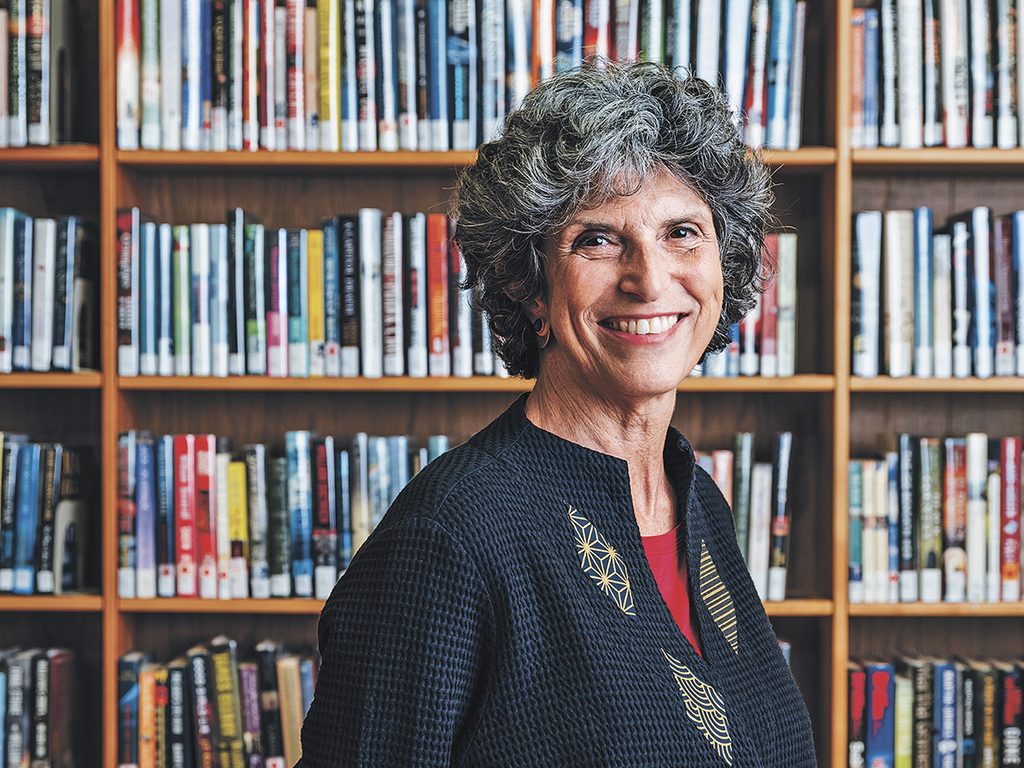How I Created a Sanctuary for Teenagers in My School Library

When Angela Jouris Saxe started her job, she realized that a school library is more than just a place to do research—it's a refuge for marginalized or bullied teens
Making Them Feel Safe in the Stacks
When I got my first library card in the mid-1950s, my love for the institution blossomed.
From the age of eight, I was allowed to walk from my house in Mount Royal, Que., across the wooden footbridge over the CN rail line to where the municipal library was housed directly above the police station. Once the librarian gave me my membership card, she suggested that I might enjoy a series of books written by Laura Ingalls Wilder, starting with Little House in the Big Woods.
The memory of curling up in an armchair and disappearing into the faraway world of pioneer life is still vivid today. I was from a Greek household, so the details of homesteading in the American West were exotic: chopping down trees to build a house, planting crops, the isolation, it all fascinated me. Time disappeared. No longer restricted to the here and now, I was free to imagine myself as a pioneer girl. I was addicted.
But the municipal library’s collection paled in comparison to what was available to us at high school. There, I read novels written by the authors we were studying in class: Charles Dickens and Joseph Conrad, Mark Twain and Emily Brontë.
During the summer months, I was caught up in Gone With the Wind and Anna Karenina or lost in the exciting and strange worlds of Ray Bradbury.
When I studied English literature at university, I thought it best to build my own library. And later, when I taught English at a high school, I continued to collect books. Forty years into my collecting, I realized that all those books had become a part of the house, like wallpaper or wood panelling. Suddenly I saw them as vanity and an insidious aspect of consumerism. Why did I have to keep every book? I held on to a select few and donated the rest. My home library is now filled only with books that have enriched my life and are of interest to my family and friends. I regularly prune my collection. A new book rarely stays with me for long.
Toward the end of my teaching career, I became a teacher-librarian. This position reignited my love and appreciation for how wonderful it is to be surrounded by books. And the school library indulged my passion for books even more.
I had a generous budget, and I searched for books that would interest my teenage audience and hopefully spark a love of reading in them. Fantasy. Science fiction. Horror. Graphic novels. I couldn’t keep the Twilight series on the shelves—too many kids wanted to borrow them. Biographies of sports heroes were in hot demand. Students raced to the library as soon as it opened (even in our digital era) to take out several books of their favourite manga series. I suggested Three Day Road, De Niro’s Game and The Ghost Road to senior boys for their independent study assignment, and the girls loved Lullabies for Little Criminals, A Complicated Kindness and Fall on Your Knees. I bought books that students asked for and ones that I wanted to read.
I quickly realized that the library wasn’t just a place to do research; students came for other reasons, as well. I noticed that some students lined up first thing in the morning, returned at break time and spent the whole lunch hour tucked away in a carrel. These were the loners and the marginalized, the ones who felt safer in the library than in the hallways or in the cafeteria where they could be bullied or harassed.
There was the young man who hid in the stacks reading philosophy books, refusing to sign them out for fear of being ridiculed at home. A young woman, who read every book on human anatomy and diseases, dreamed of being a doctor, but her family was too poor; she would have to find full-time work after graduation. I noticed that students searched for books on specific topics instead of using computers: sexually transmitted infections, drugs, LGBTQ+ issues, mental-health issues. I realized that computer screens were too visible, so I bought more books on those topics.
I bought sofas and easy chairs. The conference room doubled as an art gallery and a meeting place for students to talk about ideas, play chess, start knitting circles and make posters for their clubs. The library became an inclusive public space, democratic and safe for everyone. The circulation rates for books rose five to 10 per cent every month.
My years as a teacher-librarian—non-judgmental, resourceful and always accommodating—were the most rewarding of my career. Even though I was an authority figure, I wasn’t involved with student assessments and evaluations or restricted by the rigid structure of the curriculum. I was free to make the library a comfortable and exciting place to learn.
Whether libraries are located in schools or in communities, I believe they provide students and the public with an opportunity to engage with the past, the present and the future; all that is required is a modicum of curiosity. Libraries are vibrant and fluid places that help us to adjust to the world, and their doors must be kept open to everyone—for free.
Next, see a list of the Reader’s Digest Book Club picks.



